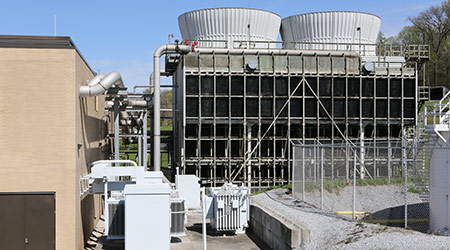Introduction
Since 2009, the Penn State Health Milton S. Hershey Medical Center has been implementing a multiphase energy efficiency program. Six years into the program, Kevin Kanoff, the center’s campus energy engineer, knew the chiller plants were efficient—but he believed they could be improved. The primary contractor, Johnson Controls, brought in partner Optimum Energy to perform an engineering site assessment (ESA), which proved him correct: optimizing the chiller plants across the campus would deliver significant energy savings.
After Optimum Energy completed the installation of its OptiCx™ platform and OptimumLOOP™ in June 2016, the center’s 12 chillers were running at peak efficiency, saving electricity costs, using less water, and reducing carbon emissions. In fact, annual energy savings were found to be almost 4.2 GWh/year, roughly 1 GWh more than expected, and campus energy intensity dropped 4 percent.
The challenge: Optimizing a large, efficient plant
The plant optimization project was not a small task. The Milton S. Hershey Medical Center serves more than 1.2 million patients and employs 10,000 people. The campus—which includes two hospitals, five institutes, and Penn State University’s College of Medicine—has 2.6 million square feet of air-conditioned building space served by three chiller plants: a central plant of eight chillers and two satellite plants with two chillers each that provide a total of 14,200 tons of cooling. The system also includes a 1.4 million gallon chilled-water storage tank.
The previous phases of the energy efficiency initiative had reduced the campus’s energy intensity by 20 percent, but Kanoff had to find a way to squeeze out additional efficiencies. The ESA showed that optimization would provide the additional energy savings he sought.
First, Johnson Controls (the center’s lead vendor and Optimum Energy’s partner in the project) paved the way for the optimization solution and analytics platform, installing variable-speed drives on pumps and fans, and adding power meters and sensors for precise measurement of all system components and fully automating the manual plant.
Recognizing that the security of data systems is a high priority for a medical facility, Optimum Energy worked closely with the center’s IT staff to ensure all data going from the plant in Hershey to Optimum Energy’s cloud-based OptiCx platform would be absolutely secure.
The solution: A holistic system with real-time analytics and relational control
Optimum Energy’s OptimumLOOP relational control provided a solution that optimizes the plant holistically—it automatically stages all the chillers and the chilled-water storage tank as an integrated whole, choosing the best option based on equipment efficiency and demand for cooling. The software continuously collects data from Johnson Controls’ Metasys BAS about plant operations, outside conditions, and hundreds of other parameters, and calculates how to operate for peak efficiency and operational stability. It then adjusts the set points of pumps, fans, and other components in real time. The result of combining this system with the data analytics of the OptiCx platform is what Optimum Energy calls True Optimization.
The implementation at all three plants went smoothly, says Kanoff. “And, from a building environment perspective, the system went through start-up seamlessly. Critical patient areas were not compromised.”
Optimization also streamlined chiller operations that staff had performed manually without having a complete picture of the system.
“The team still monitors the chillers and verifies the data, but now they do it with OptimumLOOP,” says Kanoff, noting that facility operators had been skeptical at first. “Now they’re able to accomplish more, managing and operating the entire plant without the old white-knuckle approach.”
Results: Energy and cost savings beyond expectations
The payoff goes well beyond ease of operation. OptimumLOOP reduced the center’s energy intensity by 4 percent, bringing the campuswide reduction to 24 percent over 2009 levels.
“We initially projected an energy savings of 3.4 GWh annually, but the electric utility’s evaluator found that savings are actually 4.16 GWh annually,” says Kanoff. That translates into electricity costs savings of about $300,000 a year; he originally projected that the system would save $261,000 a year. As a bonus, the medical center earned a onetime $416,000 incentive from the utility.
The center has significantly decreased its carbon footprint. The optimization project has saved 7 million pounds of CO2 emissions through March 2017. It is also saving more than 1.4 million gallons of water per year as a result of the reduced energy consumption.
“Through this project, we are more aware of energy efficiency and savings,” said Kanoff. “It’s helping the team see the bigger picture—we’re not just providing chilled water, but we’re doing it as efficiently as possible and, ultimately, saving money.”
DETAILS
COOLING PLANTS
Central plant: eight chillers and a 1.4 million gallon chilled-water storage tank. Two satellite chiller plants of two chillers each. 280 air-handling units serve the conditioned space. Annual energy consumption is approximately 112,000,000 kW of electricity and 573,000 MMBtu of natural gas.
Cooling capacity: 14,200 tons
Chilled water production: 24.8 million ton-hours
MILTON S. HERSHEY MEDICAL CENTER
2.6 million square feet of conditioned space on the chiller system
4,942 hours of cooling per year
Benefits
-
Energy savings
-
Demand savings
-
Cost savings
-
Automated facilities operations
-
CO2 emissions reductions
-
Water savings
Plant efficiency improvement
Annual average plantwide efficiency, pre-optimization: 0.828 kW/ton
Annual average plantwide efficiency, post-optimization: 0.646 kW/ton
Utility savings (annual, projected)
Electrical energy savings: 4.16 GWh/year
Electrical demand reduction: 874 kW
CO2 emissions reductions: 3,220 tons/year
Water use savings: over 1.44 million gallons/year
Financial savings (annual, projected)
Annual electricity cost savings: $300,000
Estimated ROI: 4.3 years (includes incentive)

 UF Health Hospitals Rely on Green Globes to Realize Their Full Potential
UF Health Hospitals Rely on Green Globes to Realize Their Full Potential How Healthcare Facilities Can Be Truly Disaster-Resilient
How Healthcare Facilities Can Be Truly Disaster-Resilient TriasMD Breaks Ground on DISC Surgery Center for San Fernando Valley
TriasMD Breaks Ground on DISC Surgery Center for San Fernando Valley Bigfork Valley Hospital Falls Victim to Data Breach
Bigfork Valley Hospital Falls Victim to Data Breach AI-Driven Facilities: Strategic Planning and Cost Management
AI-Driven Facilities: Strategic Planning and Cost Management